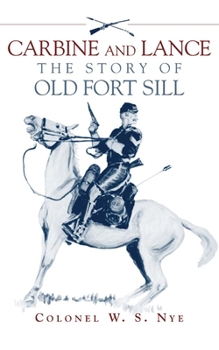Carbine and Lance: The Story of Old Fort Sill
Select Format
Select Condition 
Book Overview
Fort Sill, located in the heart of the old Kiowa-Comanche Indian country in southwestern Oklahoma, is known to a modern generation as the Field Artillery School of the United States Army. To students of American frontier history, it is known as the focal point of one of the most interesting, dramatic, and sustained series of conflicts in the records of western warfare. From 1833 to 1875, in a theater of action extending from Kansas to Mexico,...
Format:Paperback
Language:English
ISBN:0806118563
ISBN13:9780806118567
Release Date:September 1983
Publisher:University of Oklahoma Press
Length:464 Pages
Weight:1.48 lbs.
Dimensions:1.3" x 6.0" x 9.0"
Customer Reviews
3 ratings
Mesmerizing and Intense
Published by Thriftbooks.com User , 15 years ago
This is the story of the Old Fort Sill, established by General Sheridan to guard against white raids into, and Indian raids out of, the Comanche and Kiowa Indian reservations. It is not a pleasant story. In 1867 Indian depredations on the Southern Plains were unchecked and numerous Plains tribes, primarily the Comanche and the Kiowa, refused reservation life. With the approval of President Johnson, General Sherman ordered a three pronged attack on these tribes that resulted in Custer's thrashing the Kiowa on Washita Creek. Department Commander Phil Sheridan subsequently ordered the establishment of Ft. Sill on the Kiowa reservation to directly control the Kiowa. But direct control was not to be. With President Grant's election in 1868, he transferred responsibility for Indian affairs from the Army to the Interior Department, enlisting the assistance of the Nation's religious groups to pacify the Indians. It proved to be a most well intentioned, colossal error. Except for the people who lived on the frontier, no one understood that with this policy the Plains Indians and the frontiersmen's fundamental nature guaranteed anarchy. The Plains Indians, especially the Comanche, hated the Texans and had been warring with the Mexicans for well over 100 years. They saw both groups as fair game. Suddenly thrown into the mix of prey was the Army, the railroad and the Interior Department itself. With the transfer of control the Indians understood immediately what it subsequently took the US government six years to resolve. The reservation system provided free sanctuary, a base of operations within which the Indians could not be directly challenged by the Army and from which they could wreak devastation everywhere outside of the reservation. Better yet, when they tired of their raiding and returned to the reservation, they were fed, clothed, remounted and rearmed by the Interior Department. With the United States government aiding and abetting Comanche, Kiowa and Arapaho military campaigns no wonder the Indians viewed everyone else with arrogance and derision. Amazingly, despite howls of protest by the Mexican government and everyone on the frontier, the Interior Department would pursue its "peace initiative" for years while the railroad and US Army columns were attacked, Texas was ravaged and raids into Mexico as far south as the Yucatan Peninsula resulted in a most amazing pattern of pillage and plunder, including a slave trade, with Texas and Mexican women and children often ransomed to the US government courtesy of the Interior Department. It truly was the Wild West. But once the Indians began directly threatening Interior Department personnel, Interior made common cause with the Army and the mayhem ended. As Phil Sheridan had anticipated, Fort Sill became one of the key posts from which the ultimate subjugation of the Plains Indians occurred. We can be thankful that the author, Colonel Wilbur Nye, wrote this work in the 1930s while stationed at Fort
You can almost still hear the hoofbeats
Published by Thriftbooks.com User , 18 years ago
I have some sentimental connection to this book, as my dad did went to Fort Sill for artillery training in the early 1950s. While it's true this book tells the story of the southern Plains Indians Wars from an Army perspective, that's to be expected, as this story is about an Army fort and Army cavalry of the era. That said, this is a great book to get a feel of that era on the saddle, especially if you combine it with something like "40 Miles a Day on Beans and Hay."
A Solid Sense of History
Published by Thriftbooks.com User , 24 years ago
Having lived in SW Oklahoma off and on for my entire life, I am fascinated with the history of the area. All those places I had visited so often I can now tie to events long before my time.Aside from solidifying my bonds to the region, COL Nye weaves an interesting and exciting tale of the Plains Indians and the rapidly growing USA. If your knowledge of frontier life comes from John Wayne movies (not that there's anything wrong with that), this book will open your eyes to the whole story.






